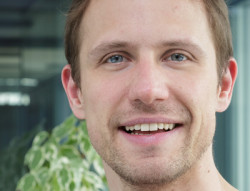
[2013-06-17] The quantum physicists in Innsbruck welcome an addition to their team: Gerhard Kirchmair – a young aspiring physicist who brings a new technology to the Tyrol. The young scientist will investigate quantum mechanical phenomena by using superconducting circuits to build hybrid architectures for quantum information processing.
The physicists in Innsbruck use different approaches to study quantum mechanical phenomena. Whether they use ultracold atoms, quantum gases or trapped ions, the Tyrolean research groups are among the international leaders in this field. With the appointment of Gerhard Kirchmair as professor, another approach will be added to this research field. The young scientist graduated in physics at the University of Innsbruck and received his doctorate sub auspiciis with experimental physicist Rainer Blatt. He worked as a postdoc at the renowned Yale University in New Haven, USA for two years, where in Rob Schoelkopf’s research group he studied the research field he is now going to establish in Innsbruck: quantum research with superconducting circuits.
“With these circuits we will be able to engineer artificial atoms, which have some properties similar to real atoms,” explains Gerhard Kirchmair. “We can design these circuits in such a way that they can be used as quantum bits (Qubits).” This is where the physicist’s expertise comes in: While the technology of superconducting circuits is now well established, the design of artificial qubits and their interactions present a real challenge for the researchers. “We would like to start using superconducting qubits for similar experiments as my colleagues already do with other technologies,” says Kirchmair. “For example, we want to implement quantum gates, test algorithms and carry out quantum simulations.”
Cold circuits
The set up of Kirchmair’s experiment is, however, completely different to the ones of the other groups. The main part of his experiments constitutes a Kryostat, a cryogen free dilution refrigerator, where superconducting circuits are cooled to a few millikelvin above absolute zero. “Compared to the other quantum optical experiments, my set up is relatively simple as additional cooling by lasers is not necessary,” says Kirchmair. Superconductors, where current flows without resistance, can be used to build, for example, capacitors or coils for circuits. Kirchmair uses a specific type of coils to build artificial qubits: so called Josephson junctions. Here, two superconductors are separated by an isolating oxide film, generating non-linear behaviour, which is essential for quantum experiments. In the long term Gerhard Kirchmair wants to couple this technology with other systems. “If we want to build a quantum internet, we need interfaces between superconducting qubits and optical photons, which we can send around the world in optical fibers,” says the Tyrolean Kirchmair when looking into the future.
A model for the future
Gerhard Kirchmair started his post as professor for experimental physics, which is limited to five years, in March 2013. He has also been appointed Junior Research Director at the Institute for Quantum Optics and Quantum Information (IQOQI) of the Austrian Academy of Sciences. He is going to use the IQOQI laboratories to set up his experiment. A Kryostat has just been delivered and Kirchmair intends to start his first experiments at the beginning of next year. He will have to show findings in five years time at the latest as his post is part of a project initiated by Peter Zoller that is similar to a tenure-track process. The goal is to give young scientists more opportunities at Austrian universities. To this end, two short-term professorships, one for theoretical physics and one for experimental physics, have been established at the University of Innsbruck and the IQOQI.
